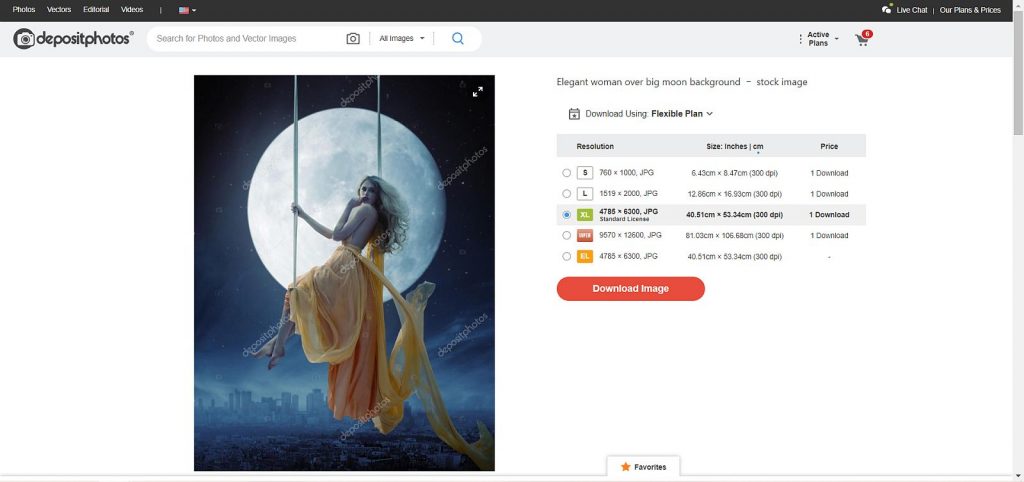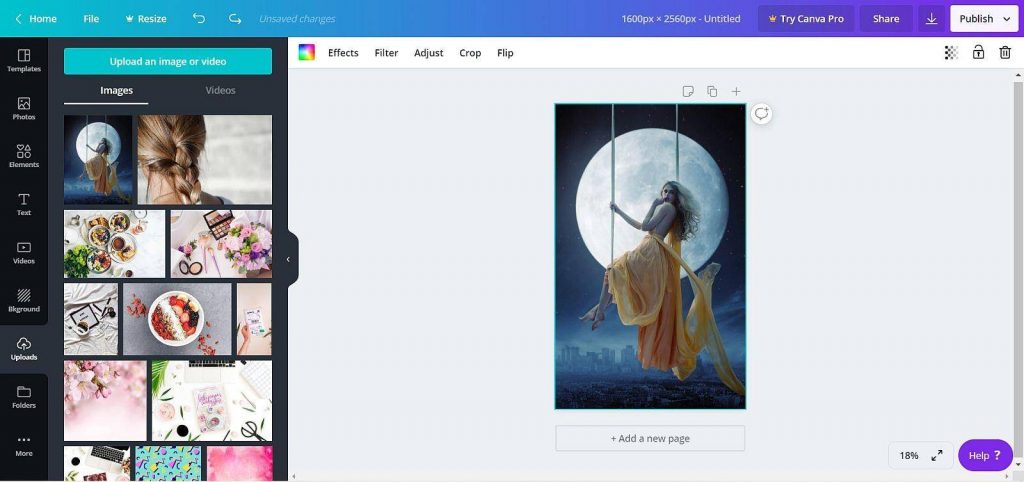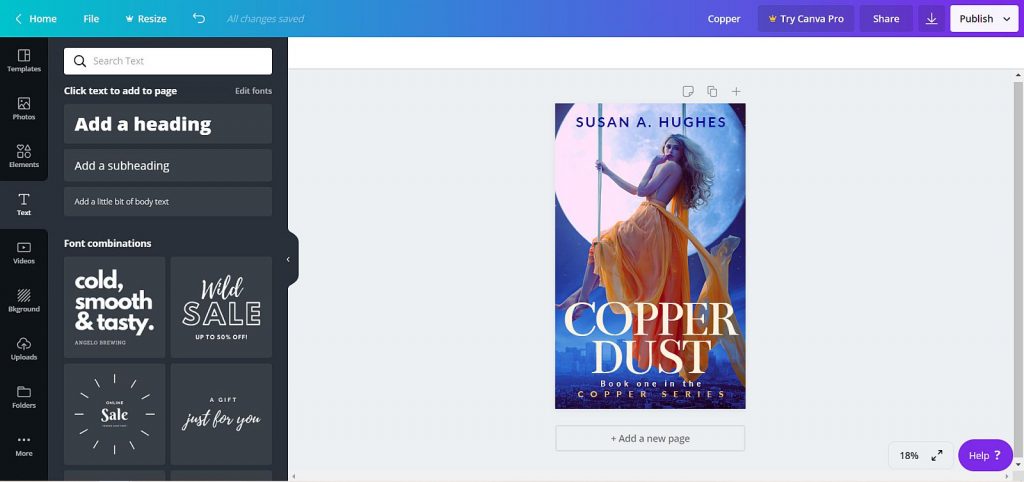- By Ana
- May 10, 2020
- 10:20 am
Author’s complete guide to book cover design and how to create a best-selling e-book cover with Canva.
In over eight years of experience designing book covers for numerous authors around the world, I had the opportunity to answer a myriad of questions on the process of book cover design and book publishing. This guide is meant to familiarize you with the basics of designing a cover, from determining what your target audience is to helping you understand how to hire the perfect designer for your project. As an added bonus you’ll also have the chance to learn how to quickly create your own e-book cover design with the help of Canva.
Hi, I’m Ana Grigoriu-Voicu, book cover designer to independent and best selling authors all around the world. My focus lies on creating powerful visual stories for your published masterpieces. Via my blog I’m aiming towards providing you with the unique artistic perspective of someone who wants to turn each project into a best-seller. If you want to find out more about my work or you’d like to stay in contact, feel free to connect with me over Facebook, Instagram or e-mail.
Designing your own book cover vs. hiring a book cover designer
First thing to decide is whether you’d like to create your own book cover or hire a professional book cover designer. It’s important to note that unless you have some pretty good knowledge of Adobe Photoshop or InDesign, creating a publishing compliant paperback by yourself will prove to be quite a challenge. However if you’d like to try your hand at designing the e-book cover art by yourself then the next couple of recommendations will guide you towards the best technical and artistic resources currently available online. A detailed step-by-step tutorial on how to create your own eBooks cover with Canva is also available down below.
Determining your target audience
The first thing you need to do is to establish your target audience. For that you will need to do a little research to understand who your readers are and what they’re attracted to. Googling “who reads YA fiction” for instance will bring up a lot of relevant results for an author interested in targeting young adult fiction readers. Knowing what appeals to your potential readers will make it easier for you to choose the right type of cover design for your book.
Deciding on a particular design style
The overall design style that you choose for your cover should integrate nicely within the genre and category your book is part of. What is typical in terms of composition for a self-help book won’t work for a YA novel. The best place to start your research is Amazon’s best seller list for the appropriate category you’re interested in. You can also gather all the material that you find in a dedicated Pinterest board that’s easily accessible anytime. Pinterest also has a pretty large collection of beautiful book covers that you can browse through and save as inspiration for later.
Once you determine what would work best for your book, it’s time to venture in the process of cover art creation. Now depending on whether you chose to DIY the cover or commission someone to create it for you, what follows will clarify some of the most important aspects of the design process.

Find your audience first and then design the cover that attracts the right readers
The stock photography duo – paid vs. public domain images
While there are some very good public domain stock image websites out there, Pixabay.com being one of them, I would advise you to opt for paid stock images instead. The main reason for my recommendation is that purchasing the rights to use a certain image is generally safer since it gives you a license of use. Stock photography is typically very affordable, with images going for $1 USD or less, depending on the website you’re purchasing them from.
Make sure you read the standard license agreement of each stock image provider to make sure you are purchasing the rights of use that are best suited for you. Likewise, take into account that chances are with public domain images that a lot of other authors might have used them for their own book covers. The last thing you want is for readers to confuse your book with someone else’s just because the covers are identical. Some of the biggest royalty-free stock image websites are Depositphotos, Shutterstock, Adobe Stock, and iStockphoto.
A quick guide on the technicalities of eBook and printed book covers
The main difference between an eBook cover and its printed counterpart is that the electronic format only features a front cover and doesn’t need a spine or back cover design. In contrast to the e-book format, the printed cover has much more diverse requirements to take into account and needs to adhere to a larger and a more specific set of guidelines. For instance, you can choose from 16 different paperback trim sizes on KDP’s publishing platform alone. You can also choose the lamination type, either glossy or matte as well as the interior paper type – cream or white. In turn, the paper type you choose influences the width of the cover spine since cream paper is usually thicker than white paper.
Almost all publishers give you the option of printing in color as well and Ingram gives you the choice of three different color alternatives. You can also choose from printing the book in paperback, hard cover or dust jacket formats with each of them having multiple sub-choices. As you can see, the amount of detail that goes into selecting the right type of format is quite considerable.
Choosing the right e-book cover dimensions
There are currently four common e-book cover sizes that you can choose from. The standard resolution of 300 ppi is what I use on all my projects and it is also the size recommended by KDP. Here are the leading e-book marketplaces and their recommended e-book cover dimensions:
Kindle Direct Publishing aka KDP
The ideal size for your e-book cover should be 2,560 x 1,600 pixels while the minimum size allowed is 1,000 x 625 pixels. The actual file size must not be larger than 50 MB and the file type should be JPG.
- Apple iBooks
While they don’t give an example of what an ideal size is, Apple iBooks recommends that an e-book cover should be at least 1400 pixels along the shorter axis. - Smashwords
Smashwords recommends a size of 1,500 to 1,800 pixels. - Bookbaby
While not giving a precise dimension, Bookbaby recommends a size of at least 1400 pixels wide and a height/width ratio of 1.6.
How to choose the right format for your printed book
The most frequently published printed books are paperbacks. They are lighter, more affordable to manufacture and come at a smaller cost for your readers than hardcovers. A hardcover format requires more material to produce, a special type of printer and the process of printing takes longer than in the case of a paperback. However, hardcovers are more durable, they feel better in the hand and are quite beautiful and decorative on a shelf. If you’d like to invest a little more in your book, then choosing to publish in hardcover format as well is very rewarding.
How to design your own e-book cover
Now that you decided on the artistic style and technical aspects of your book cover, it’s time to get creative! The easiest app you can use to create your cover is Canva. So let’s see a quick example of how to get that done.
We’ll start by choosing a representative stock image and purchasing it. For the purpose of this example I am going to use an image I bought from Depositphotos.com and design a cover mockup for an YA novel.
Step one
I’ve purchased the image at the resolution marked as XL which is perfect for our project. I saved it in an easily accessible folder and opened up the Canva app in a new browser tab.

Step two
You’ll need to log in (or create a free account) and from the home screen choose the “Custom dimension” option. I’ve typed in the chosen size (I used 1,600 x 2,560 pixels in my example) and clicked on “Create new design”. Once the new tab opens up I’m going directly to the “Uploads” tab located in the left black column. Clicking on it lets me choose a file to upload. I’m going to go with the image I purchased a few minutes ago. Once it finishes uploading, I’m going to drag and drop it on the blank page, adjusting it so that it fills the entire page and it’s centered.

Now it’s time to apply a nice filter and give the image some boost. White the image selected, I’m selecting “Filters” and then “Peony”. I like how saturated the colors are now and I find the image pretty impactful.
Step three
Another crucial step in designing a book cover is to choose the appropriate fonts for your title, subtitle and all the other text you’re going to see on the cover.
I’m going to choose “Text” from the options panel and click on “Add a heading”. I’m going to go with “Copper dust” as the title. I’m also changing the color to off-white and to uppercase.
Time to choose the right font for our title – clicking on the font name located in the top bar opens up the fonts tab on the left. I think the best font option for this cover is “Bentham”. Now for the author name font I’m going to go with “Lato Bold” (an easily readable font) and place it on top of the cover. The series introduction looks best under the title, in the same font as the author name but in two different color combinations. Before saving the cover I’m going to resize the background image to better fit with all the text elements

Clicking on the download button on the top right corner will let you save your project. Saving the file as a PNG is the best option since it’s a lossless format. You can convert it to JPG later on, before uploading it to KDP or to your publisher of choice. Here is a comparison between the original stock image I purchased and the e-book cover design I created with Canva.


Move the slider to reveal the full e-book cover
Hiring a professional book cover designer
Designing your own book cover with free apps such as Canva can be fun, however you won’t be able to get the level of story-relevant accuracy you might look for by using just one stock image. Furthermore, if you plan on publishing your work in paperback format as well, then you’ll need the help of a designer since free online apps don’t have the necessary tools to create the right file formats. If you decide to hire a book cover designer then you can expect to have almost all your artistic wishes fulfilled. Depending on the level of detail that you wish to achieve and the hours of work involved in bringing your concept to life, a professional cover designer will charge you anywhere from $300 to $1500 USD or more.
The upper tier designers will also usually include (besides custom artwork based on stock photography), hand-drawn illustration and digital painting services as well. These are highly skilled professionals with thousands of hours of practice behind them, therefore a higher fee for a complex cover design project is quite natural. Of course this all depends on how elaborated your project actually is.
Hiring a professional book cover designer is an investment in your own brand as an author.
How to find the best book cover designer for your project
It’s only natural to look for the most affordable price for a readily-available item that you want to buy. After all if it helps you just the same, why would you pay more? However this doesn’t really apply to made-to-measure, custom services such as graphic design, since art is a highly subjective matter and each artist has its own signature. If you’d like to hire a book cover designer then start by looking at artists’ portfolios first. Once you narrow it down to a couple of designers whose work you admire, contact them with a detailed email and see which one agrees to take on the project.
Important elements such as the type of art you’re looking for, whether you want an illustrated or digitally painted artwork, if you’d like for your characters to be part of the cover art or if you’re expecting a tight publishing deadline – they all influence the total price of the project. If you’d like to base your design off of a certain stock image from a more expensive photography provider then you’ll have to factor that in as well.
Stock images can start at $1 USD and go up to $500 or more per image. However generally speaking most designers will use a mix of stock images that cost from a couple of dollars per picture to about $25 USD for the more special ones. All things considered, a typical fiction cover design that makes use of 5 to 10 traditional stock images could cost anywhere between $400 and $800 USD if extensive character design and detailed digital painting services are not included.
Conclusion
Outlining what you would like to achieve with your cover design project, your wishes and expectations and offering your designer all these details will help you get the best cover design for your book at the most affordable price. Designing a book cover can sometimes seem like an intimidating process, however once you figure out the essential steps it all becomes an entertaining, creative venture for both author and graphic designer.
If you have any comments, questions, or just want to say ‘Hi’, feel free to contact me.
Share this article:


